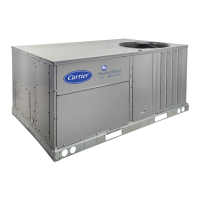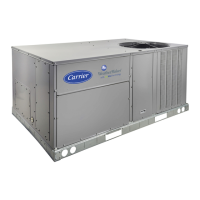58
Additionally, SP.CF must be set to 0 (None) when a unit is
equipped with optional VFD bypass and is operating in Bypass
mode. Failure to change this configuration in Bypass mode
will result in the indoor fan motor running continuously.
1 (VFD Control)
This will enable the use of ComfortLink controls for static
pressure control via a supply fan VFD.
Constant Vol IDF ia VFD? (CV.FD)
This variable enables the use of a CV unit with VFD for staged
air volume control.
Static Pressure Fan Control? (SP.FN)
This is automatically set to Yes when SP.CF = 1 or when
CV.FD is set to Yes. When the user would like the 4 to 20 mA
output to energize the VFD, as opposed to the fan relay, SP.FN
may be set to Yes when SP.CF = 0. When the control turns the
fan ON, the control will send the SP.MX value of the 4 to 20
mA signal to the third party VFD control.
Additionally, SP.FN must be set to NO when the unit is
equipped with optional VFD bypass and is operating in Bypass
mode. Failure to change this configuration in bypass mode will
result in the indoor fan motor running continuously.
Static Pressure Sensor (SP.S)
This variable enables the use of a supply duct static pressure
sensor. This must be enabled to use ComfortLink controls for
static pressure control. If using a third-party control for the
VFD, this should be disabled. This is not used when CV.FD is
set to Yes.
Static Pressure Low Range (SP.LO)
This is the minimum static pressure that the sensor will mea-
sure. For most sensors this will be 0 in. wg. The ComfortLink
controls will map this value to a 4 mA sensor input.
Static Pressure High Range (SP.HI)
This is the maximum static pressure that the sensor will mea-
sure. Commonly this will be 5 in. wg. The ComfortLink con-
trols will map this value to a 20 mA sensor input.
Static Pressure Setpoint (SP.SP)
This is the static pressure control point. It is the point against
which the ComfortLink controls compare the actual measured
supply duct pressure for determination of the error that is used
for PID control. Generally one would set SP.SP to the mini-
mum value necessary for proper operation of air terminals in
the conditioned space at all load conditions. Too high of a val-
ue will cause unnecessary fan motor power consumption at
part load conditions and/or noise problems. Too low a value
will result in insufficient airflow.
VFD Minimum Speed (SP.MN)
This is the minimum speed for the supply fan VFD. Typically the
value is chosen to maintain a minimum level of ventilation. When
CV.FD = Yes, the range is 0 to 100% still with the default set-
ting of 67%.
VFD Heating Minimum Speed (HT.V.M)
This is the low speed setting for units in heating mode. The
range is 75 to 100% with the default setting of 75%.
NOTE: Most VFDs have a built-in minimum speed adjustment
which must be configured for 0% when using ComfortLink con-
trols for static pressure control.
VFD Maximum Speed (SP.MX)
This is the maximum speed for the supply fan VFD. This is
usually set to 100%.
VFD Fire Speed Override (SP.FS)
This is the speed that the supply fan VFD will use during the
pressurization, evacuation and purge fire modes. This is usual-
ly set to 100%.
Static Pressure Reset Configuration (SP.RS)
This option is used to configure the static pressure reset func-
tion. When SP.RS = 0, there is no static pressure reset via an
analog input. If the outdoor air quality sensor is not configured
(Configuration
IAQ
IAQ.CF
OQ.A.C = 0), then it is
possible to use the outdoor air quality sensor location on the
CEM board to perform static pressure reset via an external 4 to
20 mA input.
Configuring SP.RS = 1 provides static pressure reset based on
this CEM 4 to 20 mA input and ranges from 0 to 3 in. wg. Wire
the input to the CEM using TB6-11 and 12. When SP.RS = 2,
there is static pressure reset based on RAT and defined by
SP.RT and SP.LM. When SP.RS = 3, there is static pressure re-
set based on SPT and defined by SP.RT and SP.LM.
Setting SP.RS to 1, 2 or 3 will give the user the ability to reset
from 0 to 3 in. wg of static pressure. The reset will apply to the
supply static pressure setpoint. The static pressure reset func-
tion will only act to reduce the static pressure control point.
As an example, the static pressure reset input is measuring 6
mA, and is therefore resetting 2 mA (6 mA – 4 mA) of its 16
mA control range. The 4 to 20 mA range corresponds directly
to the 0 to 3 in. wg of reset. Therefore 2 mA reset is 2/16 * 3 in.
wg = 0.375 in. wg of reset. If the static pressure setpoint
(SP.SP) = 1.5 in. wg, then the static pressure control point for
the system will be reset to 1.5 – 0.375 = 1.125 in. wg.
When SP.RS = 4, the static pressure reset function acts to pro-
vide direct VFD speed control where 4 mA = 0% speed and 20
mA = 100% (SP.MN and SP.MX will override). Note that
SP.CF must be set to 1 (VFD Control), prior to configuring
SP.RS = 4. Failure to do so could result in damage to ductwork
due to overpressurization. This is the recommended approach
if a third party wishes to control the variable speed supply fan.
In effect, this represents a speed control signal “pass through”
under normal operating circumstances. The ComfortLink con-
trol system overrides the third party signal for critical operation
situations, most notably smoke and fire control.
Static Pressure Reset Ratio (SP.RT)
This option defines the reset ratio in terms of static pressure
versus temperature. The reset ratio determines how much is the
static pressure reduced for every degree below setpoint for
RAT or SPT.
Static Pressure Reset Limit (SP.LM)
This option defines the maximum amount of static pressure re-
set that is allowed. This is sometimes called a “clamp.”
NOTE: Resetting static pressure via RAT and SPT is primarily a
constant volume application which utilizes a VFD. The reasoning
is that there is significant energy savings in slowing down a supply
fan as opposed to running full speed with supply air reset. Main-
taining the supply air setpoint and slowing down the fan has the
additional benefit of working around dehumidification concerns.
Static Pressure Reset Economizer Position (SP.EC)
This option effectively resets ECONOMIN to fully occupied
ventilation position, to account for the drop in static pressure
during static pressure reset control. The static pressure reset for
the calculation cannot be larger than the supply air static set-
point (SPSP).
The calculation is as follows:
(Static Pressure Reset/SP.LM) x (ECONOSPR – ECONOMIN)
As an example, the static pressure reset limit (SP.LM) = 0.75
in. wg. The current static pressure reset is set to 0.5 in. wg. The
settings for ECONOSPR = 50% and ECONOMIN = 20%.

